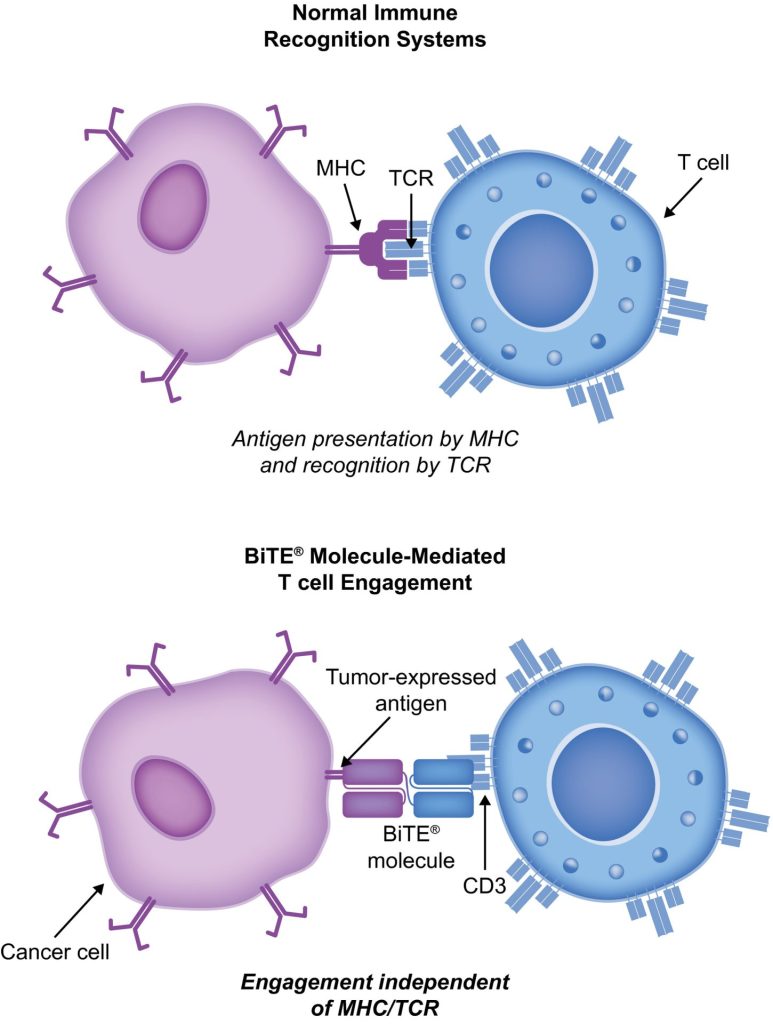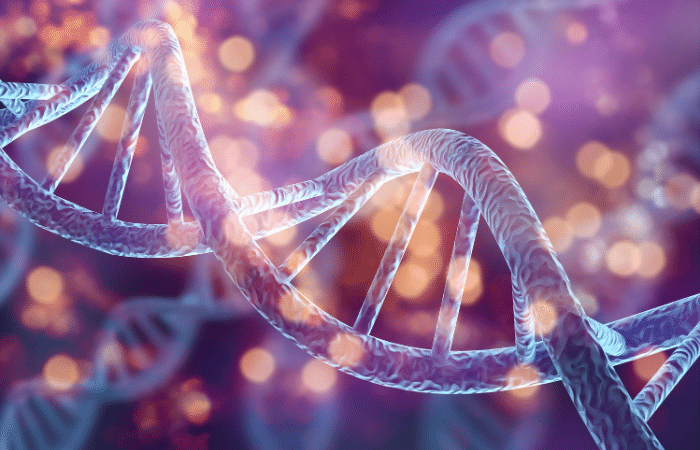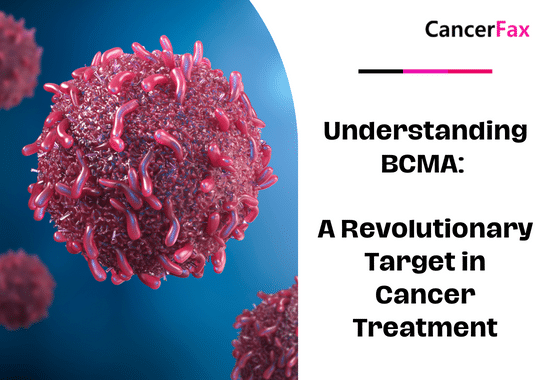Immuno-oncology is a way to treat cancer by using the body’s immune system. BiTE (bispecific T-cell engager) technology is a targeted immuno-oncology platform that binds a patient’s own T cells to cancer cells. Because BiTE technology is flexible, it is easy to make molecules that attack tumor-specific antigens, which makes immuno-oncotherapy possible. Blinatumomab was the first standard BiTE molecule to be approved. It targets CD19 surface antigens on B cells and is mostly unaffected by genetic changes or escape mechanisms inside cells. More BiTE molecules are being made to treat other blood cancers (like multiple myeloma, acute myeloid leukaemia, and B-cell ನಾನ್-ಹಾಡ್ಗ್ಕಿನ್ ಲಿಂಫೋಮಾ) and solid tumours (like prostate cancer, glioblastoma, stomach cancer, and small-cell lung cancer). BiTE molecules that have a longer half-life than the standard ones are also being made. With BiTE technology, advances in immuno-oncology could make it easier to treat both blood and solid tumours and make them more effective when used with other treatments.
BiTe ಚಿಕಿತ್ಸೆ ಎಂದರೇನು?
Immuno-oncology therapies are scientifically proven ways to treat different types of solid and ರಕ್ತ ಕ್ಯಾನ್ಸರ್. Hematologic cancers are a good fit for treatments that target the immune system because cancerous blood cells move around with immune cells. Several ಇಮ್ಯುನೊ ಕ್ಯಾನ್ಸರ್ ಚಿಕಿತ್ಸೆಗಳು ಕೆಲಸದಲ್ಲಿವೆ.
Monoclonal antibody checkpoint inhibitors that stop the binding of checkpoint proteins (like PD-1 and CTLA-4) are useful against many types of cancer. They work well and are safe for many solid tumours, especially when they target PD-1. Non-small-cell lung, kidney, and bladder cancers have all been treated successfully with these drugs. But many people don’t react to checkpoint inhibitors or get sick again after taking them. Except for non-Hodgkin ಲಿಂಫೋಮಾ, most results on hematologic cancers have been disappointing, especially for myeloma and leukaemia, where the overall response rate in approved indications ranges from 12.0% to 48.5%.8-15.
Other immuno-oncology treatments, on the other hand, have a higher success rate. Chimeric antigen-receptor (CAR) T-cell therapies change a patient’s T cells to attack a specific cellular antigen, such as CD19 in the treatment of B-cell malignancies and B-cell maturation antigen (BCMA) in the treatment of ಬಹು ಮೈಲೋಮಾ (MM). CAR T-cell treatments have shown promise in treating hematologic cancers. They haven’t been as effective in treating solid tumours, but there have been some good results with ನ್ಯೂರೋಬ್ಲಾಸ್ಟೊಮಾ, human epidermal growth factor receptor tumours, and non-small-cell lung cancer. The genetic modification and in vitro multiplication of T cells take a long and complicated manufacturing process. This is a downside of this therapy because it makes it harder for patients to get this treatment quickly and in large numbers. The fact that lymphodepletion through chemotherapy preparation must be done first as a requirement for improved effectiveness is also a drawback.
BiTE (ಬಿಸ್ಪೆಸಿಫಿಕ್ ಟಿ-ಸೆಲ್ ಎಂಗೇಜರ್) ಚಿಕಿತ್ಸೆಗಳು ರೋಗಿಯ ಸ್ವಂತ ಟಿ ಕೋಶಗಳನ್ನು ಗೆಡ್ಡೆ-ವ್ಯಕ್ತಪಡಿಸಿದ ಪ್ರತಿಜನಕಗಳಿಗೆ ಲಿಂಕ್ ಮಾಡುತ್ತವೆ. ಇದು T ಕೋಶಗಳ ಜೀನ್ಗಳನ್ನು ಬದಲಾಯಿಸದೆಯೇ ಅಥವಾ ದೇಹದ ಹೊರಗೆ ಬೆಳೆಯುವ ಅಥವಾ ಕುಶಲತೆಯಿಂದ ಕ್ಯಾನ್ಸರ್ ಅನ್ನು ಕೊಲ್ಲಲು ರೋಗಿಯ ಸ್ವಂತ T ಜೀವಕೋಶಗಳ ಸೈಟೊಟಾಕ್ಸಿಕ್ ಸಾಮರ್ಥ್ಯವನ್ನು ಆನ್ ಮಾಡುತ್ತದೆ. BiTE ಅಣುಗಳನ್ನು ಹೆಚ್ಚು ಪರಿಣಾಮಕಾರಿಯಾಗಿಸಲು ಔಷಧಿಗಳಾಗಿ ಅಥವಾ ಇತರ ಚಿಕಿತ್ಸೆಗಳೊಂದಿಗೆ ಮಾತ್ರ ಬಳಸಬಹುದು.
BiTe ಕ್ರಿಯೆಯ ಕಾರ್ಯವಿಧಾನ
BiTE molecules are antibody constructs with two binding domains. One recognises tumor-expressed antigens (such as ಬಿಸಿಎಂಎ, CD19, or -like protein [DLL3]), and the other, CD3, recognises T cells (Fig. 1). Two single-chain variable fragment (scFv) regions from monoclonal antibodies are connected by a flexible peptide linker to make the binding domains. The first scFv binding region can be changed to target any surface antigen, so it can be used right away to treat a wide range of tumours and can be used again later. The second scFv binding region always binds to CD3, which is a part of the T-cell receptor complex that never changes. When a BiTE molecule interacts with both a cytotoxic T cell and a tumour cell, the T cells begin to multiply. This increases the amount of effector cells and makes BiTE therapy more effective. Then, the death of cancer cells is started. BiTE molecules can get any T cells to do this because they don’t need co-stimulation or the usual processes of the major histocompatibility complex.

Blinatumomab is the first and only BiTE therapy that has been approved. It targets the CD19 receptor on both normal and cancerous B cells. It is a highly potent molecule with cytotoxic effects seen at low exposures (10–100 pg/mL)26. In its presence, T cells can perform serial-target lysis, quickly binding to and killing many cells. This is how BiTE therapies work, and it can be seen in other BiTE molecules that are still in research. In ತೀವ್ರವಾದ ಲಿಂಫೋಬ್ಲಾಸ್ಟಿಕ್ ಲ್ಯುಕೇಮಿಯಾ (ಎಲ್ಲ), blinatumomab has been shown to be effective and safe. In 2014, the US Food and Drug Administration gave it fast approval, and in 2017, it got full approval for relapsed or refractory (R/R) B-cell precursor (BCP) ALL. In 2018, accelerated approval was given to ಬ್ಲಿನಾಟುಮೊಮಾಬ್ for treating BCP-ALL with minimum residual disease (MRD). This was the first approval for this use. In November 2015, the European Medicines Agency also gave it a green light for BCP-ALL with a Philadelphia chromosome (Ph) that is negative and R/R. Blinatumomab is approved for R/R BCP-ALL in adults and children in 57 countries, including Japan, all countries in the European Union, Canada, and Australia.
BCP-ALL ರೋಗಿಗಳ ಚಿಕಿತ್ಸೆಗಾಗಿ Blinatumomab
Blinatumomab BCP-ALL ಅನ್ನು ಚಿಕಿತ್ಸೆ ನೀಡುವ ವಿಧಾನವನ್ನು ಬದಲಾಯಿಸಿದೆ. ಸ್ಟ್ಯಾಂಡರ್ಡ್-ಆಫ್-ಕೇರ್ (SOC) ಕಿಮೊಥೆರಪಿಗೆ ಹೋಲಿಸಿದರೆ, ಇದು ಒಟ್ಟಾರೆ ಬದುಕುಳಿಯುವಿಕೆಯನ್ನು (OS) ಹೆಚ್ಚಿಸಿದೆ ಮತ್ತು ಕೆಲವು ಅಡ್ಡ ಪರಿಣಾಮಗಳ (AEs) ಸಂಖ್ಯೆಯನ್ನು ಕಡಿಮೆ ಮಾಡಿದೆ. ಯಾದೃಚ್ಛಿಕ ನಿಯಂತ್ರಿತ ಪ್ರಯೋಗಗಳು ಸೇರಿದಂತೆ ಹಲವಾರು ಪ್ರಮುಖ ಅಧ್ಯಯನಗಳು ಬ್ಲಿನಾಟುಮೊಮಾಬ್ ಸುರಕ್ಷಿತವಾಗಿದೆ ಮತ್ತು ವಯಸ್ಕರು ಮತ್ತು ಮಕ್ಕಳಲ್ಲಿ BCP-ALL ಗಾಗಿ ಕಾರ್ಯನಿರ್ವಹಿಸುತ್ತದೆ ಎಂದು ತೋರಿಸಿದೆ. CAR ಟಿ-ಸೆಲ್ ಚಿಕಿತ್ಸೆ, 2 ಸಿಂಗಲ್-ಆರ್ಮ್ ಅಧ್ಯಯನಗಳಿಂದ (clinicaltrials.gov ID ಗಳು NCT01626495 ಮತ್ತು NCT01029366) ಡೇಟಾ ಮಾತ್ರ ಇವೆ, ಇದರಲ್ಲಿ R/R BCP-ALL ಮತ್ತು T-ಸೆಲ್ ALL ನೊಂದಿಗೆ 25 ಮಕ್ಕಳು (ವಯಸ್ಸು 5–22) ಮತ್ತು 5 ವಯಸ್ಕರು (26–60 ವರ್ಷ ವಯಸ್ಸಿನವರು) ಚಿಕಿತ್ಸೆ ಪಡೆದರು. ಆದರೆ ಫಲಿತಾಂಶಗಳು ಆಶಾದಾಯಕವಾಗಿವೆ (90% ರಲ್ಲಿ ಸಂಪೂರ್ಣ ಪ್ರತಿಕ್ರಿಯೆ [CR], 6% ರಲ್ಲಿ 67-ತಿಂಗಳ ಈವೆಂಟ್-ಮುಕ್ತ ಬದುಕುಳಿಯುವಿಕೆಯೊಂದಿಗೆ ನಿರಂತರ ಉಪಶಮನ, ಮತ್ತು ಒಟ್ಟಾರೆ ಬದುಕುಳಿಯುವಿಕೆಯ [OS] ದರ 78% [ಮಧ್ಯಮ ಅನುಸರಣೆ, 7 ತಿಂಗಳುಗಳು; ಶ್ರೇಣಿ, 1-24 ತಿಂಗಳುಗಳು]).
TOWER ಅಧ್ಯಯನ (ಎ ಹಂತ 3, ಯಾದೃಚ್ಛಿಕ, ತೆರೆದ ಲೇಬಲ್ ಅಧ್ಯಯನವು ಬೈಟ್ ಆಂಟಿಬಾಡಿ ಬ್ಲಿನಾಟುಮೋಮಾಬ್ನ ಪರಿಣಾಮಕಾರಿತ್ವವನ್ನು ಪರಿಶೀಲಿಸುತ್ತದೆ ಮತ್ತು ವಯಸ್ಕರ ವಿಷಯಗಳಲ್ಲಿ ಸ್ಟ್ಯಾಂಡರ್ಡ್ ಆಫ್ ಕೇರ್ ಕೀಮೋಥೆರಪಿ ಮರುಕಳಿಸಿದ/ವಕ್ರೀಭವನದ ಬಿ-ಪೂರ್ವಭಾವಿ ALL; clinicaltrials.gov ಹೋಲಿಕೆಯ ಪರಿಣಾಮಗಳ ವಿರುದ್ಧ NCT02013167. ಪಿಎಚ್-ನೆಗೆಟಿವ್, ಆರ್/ಆರ್ ಬಿಸಿಪಿ-ಎಎಲ್ಎಲ್ನೊಂದಿಗೆ ಹೆಚ್ಚು ಪೂರ್ವ ಚಿಕಿತ್ಸೆ ಪಡೆದ ವಯಸ್ಕರಲ್ಲಿ ಎಸ್ಒಸಿ ಕಿಮೊಥೆರಪಿ. ಜನರು ಹೆಚ್ಚು ಕಾಲ ಬದುಕುತ್ತಿದ್ದರಿಂದ, ಅಧ್ಯಯನವನ್ನು ಮೊದಲೇ ನಿಲ್ಲಿಸಲಾಯಿತು. Blinatumomab ಗುಂಪಿನಲ್ಲಿರುವ AE ಗಳು ಹಿಂದಿನ ಅಧ್ಯಯನಗಳಲ್ಲಿ ಕಂಡುಬರುವಂತೆಯೇ ಇದ್ದವು ಮತ್ತು Blinatumomab SOC ಗಿಂತ ಕಡಿಮೆ ಮಾನ್ಯತೆ-ಹೊಂದಾಣಿಕೆಯ AE ದರಗಳನ್ನು ಹೊಂದಿತ್ತು.
30% to 50% of people with BCP-ALL in complete hematologic remission show persistent MRD. In the single-arm, phase 2 BLAST study (A Confirmatory Multicenter, Single-Arm Study to Assess the Efficacy, Safety, and Tolerability of the BiTE Antibody Blinatumomab in Adult Patients With MRD of B-Precursor Acute Lymphoblastic Leukaemia; clinicaltrials.gov identifier NCT01207388), blinatumomab was tested on patients with BCP-ALL in first or later complete After blinatumomab treatment, 78% of patients who were MRD positive became MRD negative. The 5-year OS study showed a median OS of 36.5 months, and more than half of those who had a complete MRD response after the first cycle of blinatumomab were still alive at 5 years, which suggests that the treatment might be able to cure some patients. AEs were seen that were linked to ಸೈಟೊಕಿನ್ ಬಿಡುಗಡೆ ಸಿಂಡ್ರೋಮ್ (CRS).31 Other studies, like NCT03023878 and NCT03340766, are still looking at blinatumomab in first-line settings and in combination with other treatments.
CD19-targeted treatments have been linked to failure because of the loss of CD19 antigen after treatment. The failure rates for blinatumomab range from 8% to 35%, and for CAR T-ಕೋಶ ಚಿಕಿತ್ಸೆಗಳು, they range from 39% to 65%.36-40 We don’t fully understand what causes therapy to fail, but one possibility is immunoediting, in which antigen loss is caused by a T-cell-dependent process called immunoselection, which lets tumour cells get away.41 Lineage switch and epitope loss under therapy pressure have also been suggested as ways for tumours to escape treatment. However, a recent study on epitope loss found that some CD19 isoforms that help CAR T-cells escape were already present at the time of diagnosis. This suggests that combining treatments might be helpful. Another thing that can cause immunotherapy to fail is called “inhibitory T-cell signalling.” In this case, the blocking programmed death ligand-1 (PD-L1) is interesting because it is more common in B-cell ALL cells from patients who don’t respond to blinatumomab and can make CD3 BiTE molecules less effective.43 By making a CD28/PD-L1 BiTE that triggers the CD28 co-stimulatory signal instead of the inhibitory signaling pathway that is usually seen when a T cell binds to a PD-L1-expressing cancer cell, this inhibition could be turned off.43 Dual-targeted CAR T cells are also being looked into as a way to make up for the loss of tumour antigens. This can be done by modifying each T cell with 2 CAR molecules and 2 different binding domains (dual-signaling CAR) or by putting 2 different binding domains on 1 CAR molecule at the same time (TanCAR).
BiTE ಮತ್ತು ಅದರ ನಿರ್ವಹಣೆಯೊಂದಿಗೆ ಪ್ರತಿಕೂಲ ಘಟನೆಗಳು
ಬ್ಲೈನಾಟುಮೊಮಾಬ್ನ ವೈದ್ಯಕೀಯ ಅಧ್ಯಯನಗಳಲ್ಲಿ, ಜ್ವರ, ಕಡಿಮೆ ಬಿಳಿ ರಕ್ತ ಕಣಗಳ ಎಣಿಕೆ ಮತ್ತು ಕಡಿಮೆ ಪ್ಲೇಟ್ಲೆಟ್ ಎಣಿಕೆಗಳು ಸಾಮಾನ್ಯ AE ಗಳು. ಕೆಲವು ಪ್ರಮುಖ ಅಪಾಯಗಳೆಂದರೆ CRS, ನ್ಯೂರೋಟಾಕ್ಸಿಸಿಟಿ ಮತ್ತು ಡ್ರಗ್ ತಪ್ಪುಗಳು. CD19-ನಿರ್ದಿಷ್ಟ CAR T-ಸೆಲ್ ಚಿಕಿತ್ಸೆಗಳೊಂದಿಗೆ ನ್ಯೂರೋಟಾಕ್ಸಿಸಿಟಿ ಸಹ ಸಂಭವಿಸಬಹುದು, ಆದರೆ ಇದು CD19 ಕಾರಣದಿಂದಾಗಿರಬಾರದು. CD1/CD1 ಗುರಿಗಳ ಕುರಿತು ಇನ್ನೂ ನಡೆಯುತ್ತಿರುವ ಹಂತದ 20/3b ಅಧ್ಯಯನದ ಫಲಿತಾಂಶಗಳು ಗ್ರೇಡ್ 3 ಅಥವಾ ಹೆಚ್ಚಿನ CNS AE ಗಳು ಅಪರೂಪವೆಂದು ತೋರಿಸಿದೆ (ಎಲ್ಲಾ ಗ್ರೇಡ್ 3 AE ಗಳಲ್ಲಿ 3%). ಹೆಚ್ಚಿನ ಸಮಯ, CRS ಗೆ blinatumomab ನ ಪ್ರತಿಕ್ರಿಯೆಯು ಸೌಮ್ಯವಾಗಿರುತ್ತದೆ, ಆದರೆ ಅಪರೂಪದ ಸಂದರ್ಭಗಳಲ್ಲಿ, ಇದು ತೀವ್ರವಾಗಿರುತ್ತದೆ ಮತ್ತು ಜೀವಕ್ಕೆ-ಬೆದರಿಕೆಯಾಗಬಹುದು. ಕಾರ್ಟಿಕೊಸ್ಟೆರಾಯ್ಡ್ಗಳೊಂದಿಗೆ ಉರಿಯೂತದ ಪ್ರತಿಕ್ರಿಯೆಗಳನ್ನು ಕಡಿಮೆ ಮಾಡಬಹುದು. CRS ನ ಸಾಧ್ಯತೆಯನ್ನು ಕಡಿಮೆ ಮಾಡಲು, ಬ್ಲಿನಾಟುಮೊಮಾಬ್ನ ಮೊದಲ ಡೋಸ್ಗೆ ಮೊದಲು ಪ್ರೆಡ್ನಿಸೋನ್ ಅಥವಾ ಡೆಕ್ಸಾಮೆಥಾಸೊನ್ನ ಕಷಾಯವನ್ನು ನೀಡುವುದು ಮತ್ತು ಡೋಸ್ ಅನ್ನು ನಿಧಾನವಾಗಿ ಹೆಚ್ಚಿಸುವುದು ಉತ್ತಮ. ಇತರ BiTE ಅಣುಗಳ ಮೊದಲು ಕಾರ್ಟಿಕೊಸ್ಟೆರಾಯ್ಡ್ಗಳ ಈ ಬಳಕೆಯು ಇತರ BiTE ಅಣುಗಳನ್ನು ಬಳಸುವಾಗ ಡೆಕ್ಸಾಮೆಥಾಸೊನ್ ಅನ್ನು ಪೂರ್ವಭಾವಿಯಾಗಿ ಬಳಸಲು ಕಾರಣವನ್ನು ನೀಡಿದೆ. ಆದಾಗ್ಯೂ, ಈ ಪರಿಣಾಮವನ್ನು ಇಡೀ BiTE ಪ್ಲಾಟ್ಫಾರ್ಮ್ಗೆ ಅನ್ವಯಿಸಬಹುದೇ ಎಂಬುದು ಸ್ಪಷ್ಟವಾಗಿಲ್ಲ ಮತ್ತು CRS ಅನ್ನು ಎದುರಿಸಲು ಇತರ ಮಾರ್ಗಗಳನ್ನು ಪರಿಶೀಲಿಸಲಾಗುತ್ತಿದೆ. ಇಂಟರ್ಲ್ಯೂಕಿನ್ 6 ಒಂದು ಸೈಟೊಕಿನ್ ಆಗಿದ್ದು ಅದು CRS ಗೆ ಕಾರಣವಾಗುತ್ತದೆ ಮತ್ತು ಅದನ್ನು ಹೊಂದಿರುವ ಜನರಲ್ಲಿ ಅಧಿಕವಾಗಿರುತ್ತದೆ. ಇಂಟರ್ಲ್ಯೂಕಿನ್-6 ರಿಸೆಪ್ಟರ್ ಅನ್ನು ನಿರ್ಬಂಧಿಸುವ ಟೊಸಿಲಿಜುಮಾಬ್ ಅನ್ನು ಸಿಆರ್ಎಸ್ ಚಿಕಿತ್ಸೆಗಾಗಿ ಬಳಸಲಾಗುತ್ತದೆ, ಇದು ಸಿಎಆರ್ ಟಿ-ಸೆಲ್ ಚಿಕಿತ್ಸೆಯ ನಂತರ ತುಂಬಾ ಕೆಟ್ಟದಾಗಿದೆ.49 ಆಸ್ಪತ್ರೆಯಲ್ಲಿ, ಸಿಆರ್ಎಸ್ಗೆ ಚಿಕಿತ್ಸೆ ನೀಡಲು ಟ್ಯೂಮರ್ ನೆಕ್ರೋಸಿಸ್ ಫ್ಯಾಕ್ಟರ್-ಇನ್ಹಿಬಿಟರ್ಗಳನ್ನು ಸಹ ಬಳಸಲಾಗುತ್ತದೆ.


